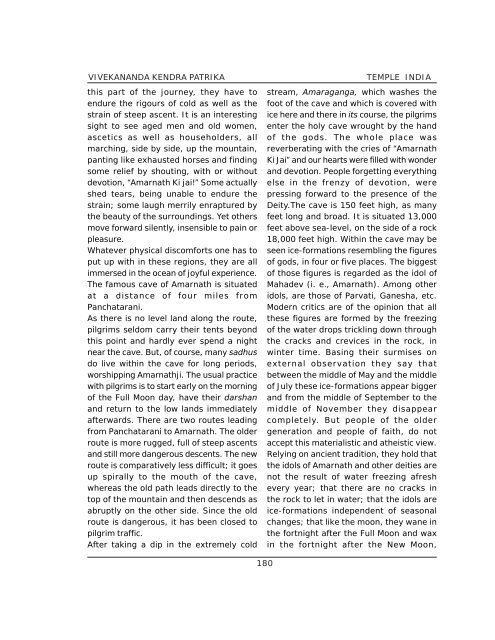Temples In India-1.pdf - Vivekananda Kendra Prakashan
Temples In India-1.pdf - Vivekananda Kendra Prakashan
Temples In India-1.pdf - Vivekananda Kendra Prakashan
You also want an ePaper? Increase the reach of your titles
YUMPU automatically turns print PDFs into web optimized ePapers that Google loves.
VIVEKANANDA KENDRA PATRIKAthis part of the journey, they have toendure the rigours of cold as well as thestrain of steep ascent. It is an interestingsight to see aged men and old women,ascetics as well as householders, allmarching, side by side, up the mountain,panting like exhausted horses and findingsome relief by shouting, with or withoutdevotion, “Amarnath Ki jai!” Some actuallyshed tears, being unable to endure thestrain; some laugh merrily enraptured bythe beauty of the surroundings. Yet othersmove forward silently, insensible to pain orpleasure.Whatever physical discomforts one has toput up with in these regions, they are allimmersed in the ocean of joyful experience.The famous cave of Amarnath is situatedat a distance of four miles fromPanchatarani.As there is no level land along the route,pilgrims seldom carry their tents beyondthis point and hardly ever spend a nightnear the cave. But, of course, many sadhusdo live within the cave for long periods,worshipping Amarnathji. The usual practicewith pilgrims is to start early on the morningof the Full Moon day, have their darshanand return to the low lands immediatelyafterwards. There are two routes leadingfrom Panchatarani to Amarnath. The olderroute is more rugged, full of steep ascentsand still more dangerous descents. The newroute is comparatively less difficult; it goesup spirally to the mouth of the cave,whereas the old path leads directly to thetop of the mountain and then descends asabruptly on the other side. Since the oldroute is dangerous, it has been closed topilgrim traffic.After taking a dip in the extremely coldTEMPLE INDIAstream, Amaraganga, which washes thefoot of the cave and which is covered withice here and there in its course, the pilgrimsenter the holy cave wrought by the handof the gods. The whole place wasreverberating with the cries of “AmarnathKi Jai” and our hearts were filled with wonderand devotion. People forgetting everythingelse in the frenzy of devotion, werepressing forward to the presence of theDeity.The cave is 150 feet high, as manyfeet long and broad. It is situated 13,000feet above sea-level, on the side of a rock18,000 feet high. Within the cave may beseen ice-formations resembling the figuresof gods, in four or five places. The biggestof those figures is regarded as the idol ofMahadev (i. e., Amarnath). Among otheridols, are those of Parvati, Ganesha, etc.Modern critics are of the opinion that allthese figures are formed by the freezingof the water drops trickling down throughthe cracks and crevices in the rock, inwinter time. Basing their surmises onexternal observation they say thatbetween the middle of May and the middleof July these ice-formations appear biggerand from the middle of September to themiddle of November they disappearcompletely. But people of the oldergeneration and people of faith, do notaccept this materialistic and atheistic view.Relying on ancient tradition, they hold thatthe idols of Amarnath and other deities arenot the result of water freezing afreshevery year; that there are no cracks inthe rock to let in water; that the idols areice-formations independent of seasonalchanges; that like the moon, they wane inthe fortnight after the Full Moon and waxin the fortnight after the New Moon,180
















